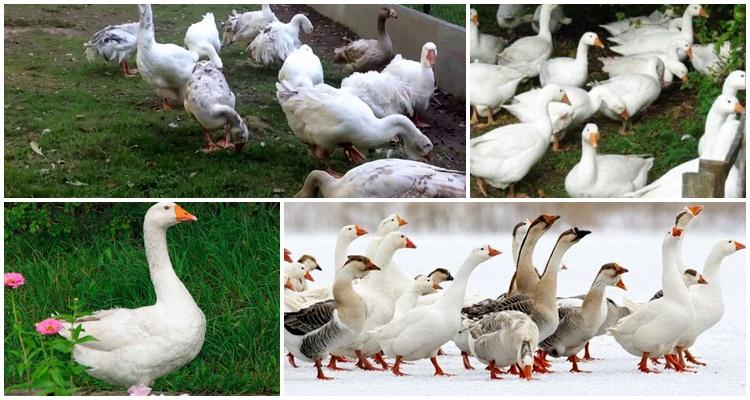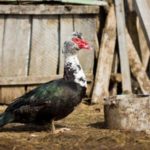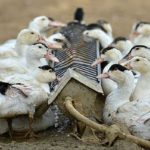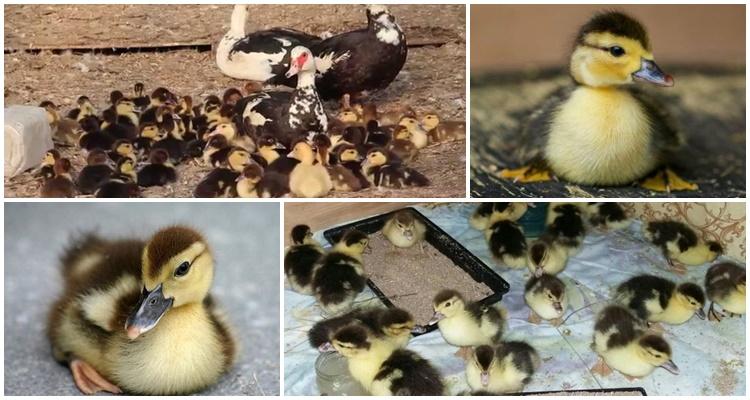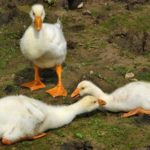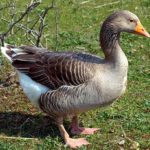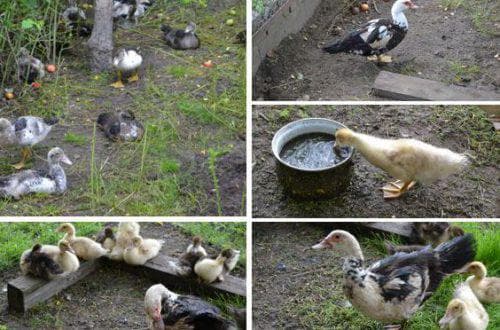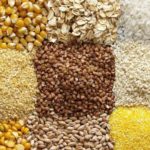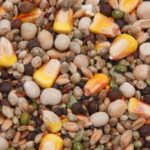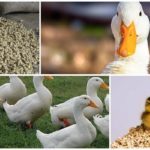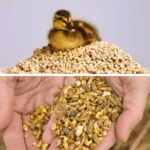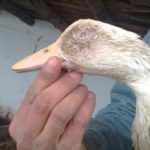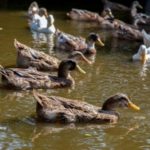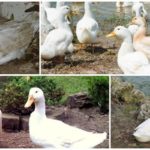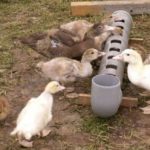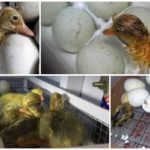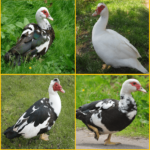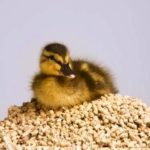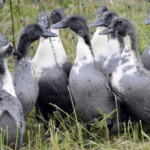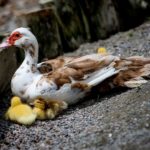The diet of mute ducks, or indo-ducks, is characterized by a high content of greenery. Birds can be released to graze freely in the summer and save on feed. For recruitment weight in duck nutrition add grain mixtures with a high protein content. But grass and grains are not all that can be fed to indo-ducks at home, because for rapid growth they need vitamins and minerals from an early age.
Basic Rules
The diet of musk ducks includes two types of food:
- grains and herbs with vitamin supplements;
- compound feed
Main components of grain feed:
- barley;
- wheat;
- oats;
- corn.
Premixes are added to cereals - ready-made vitamin complexes, as well as legumes. Peas and lupine contain protein necessary for weight gain. Premixes promote the growth and high egg production of indo-ducks. The immunity of young and sick birds is supported with the help of soluble vitamins that are added to drinking water.
Compound feed for fattening consists of 15-18 percent protein and contains the necessary grain base and vitamin supplements. After 8-12 weeks of intensive feeding, the birds are ready for slaughter. How to properly fatten turkey ducks:
- choose a balanced diet high in protein;
- give plenty of water;
- feed three times a day;
- add fresh herbs to grain and feed.
In the wild, ducks eat greens. 10 percent of the diet of poultry should also consist of forbs. To digest coarse plant fibers, ducks require crushed shell rock.
What can you feed turkey ducks?
The main nutritional requirement is a high content of protein, calcium, phosphorus and sodium.
From the first day
Feeding pattern for newborn ducklings:
| Age in days | Diet |
| First | Finely chopped boiled duck or chicken eggs
|
| Second | Corn and barley flour are added to the eggs. |
| Third | 5 grams of low-fat cottage cheese for each duckling.
Millet Chopped green onions, fresh beet tops, spinach |
| Fourth | Boiled meat waste |
Day-old chicks are given a weak solution of manganese at room temperature. Once hatched, the ducklings only eat moving objects.Therefore, they need to sprinkle chopped eggs on top. They will not see food lying motionless in a bowl.
From the third day, small chicks are fed starter feed with a protein content of 20 percent. The diet of week-old ducklings consists of wet mash with mixed feed, herbs, cottage cheese in meat or fish soup. Shredded corn and wheat are also added. From the tenth day, flour from the bones of boiled fish is added. The diet of two-week-old chicks is diluted with sunflower meal and feed yeast.
Ducklings need to be fed 6-7 times a day, at equal intervals, and given potassium permanganate to drink twice a week to prevent intestinal diseases.
From 20 days
Grown ducklings are fed with fresh grass. The amount of feed per day is increased to one hundred and ten grams per individual. Scalded nettle leaves, chopped carrots, and fish oil are added to the mute fish's diet. In summer, ducklings are given more water.
Advice for novice poultry farmers: broth mash should be prepared in an amount that the chicks will eat at one time. Half-eaten mixtures quickly spoil and attract insects. With the addition of plant food, ducklings should be given crushed eggshells, shells, fine gravel, and chalk for better digestion of hard stems.
From 30 days
Month-old ducklings are released to graze on the grass. Green food contains vitamins necessary for growth and weight gain at this age. The following amount of cereals in grams is required per duckling:
- wheat - 20;
- corn - 70;
- millet porridge - 19;
- sunflower cake - 12.
Raising Indo-Ducks can't do without swimming. Duckweed is useful for young birds. It is added to the swimming pool for ducklings. Mute mutes require a varied diet.Shellfish, potato peelings, bread crusts, and zucchini are added to food. They also continue to give yeast - 6 grams per day per individual.
Adults
Indo-ducks are fattened until they are two months old. Ducklings gain 2.5 kilograms with intensive feeding without walking. After sixty days, the birds begin their first moult and quickly lose weight.
After six months, the diet does not change significantly. The basis is cereals and greens. In second place are vegetables, boiled potatoes, carrots and beets. The diet must contain cottage cheese, bone meal and solid particles - crushed shells, gravel. Salt and chalk are used as mineral additives.
Features of nutrition in different seasons
In the spring, Indian ducks need more vitamins A, D and E. Concentrates or premixes, as well as carrots and fish oil, will help compensate for their deficiency. In summer, the emphasis is on green food, which the ducks obtain from grazing. They also provide wheat, oats, barley, and corn. During molting, ducks need sulfur, which they get from beans, cabbage, fish entrails and bones.
In winter, the weight of the ducks is supported by steamed lard, cabbage, beets and carrots. Grass meal, silage, and potatoes are added to grain crops.
Diet recipes
Experienced farmers independently prepare feed mixtures for turkey ducks. Complex recipes can be replaced with ready-made complete feeds.
Complex
Daily feeding of thirty-day-old ducklings is made saturated with the following components, indicated in grams per chick:
- grain mixture – 15-50;
- wheat – 20-30;
- corn – 40-70;
- millet – 8-19;
- meat and bone meal – 5-6;
- fish oil – 0.1-1;
- fishmeal – 9-12;
- chalk, shell - 1-5;
- yeast – 4-6;
- salt – 0.5-1.
The basis of nutrition for adult ducks is wheat, barley, oats and corn, mixed in equal quantities. The following ingredients are added to cereals, also in grams per individual:
- sunflower cake - 10;
- yeast - 4;
- bone meal - 6;
- wheat bran - 20;
- shells - 9;
- salt - 0.4.
Fish, meat broth or whey is added to the mixture.
Simple
A simple way to fatten turkey ducks is to feed them with mixed feed. There are types of ready-made mixtures:
- starting - from the first week of life;
- for growth - from the eighth week;
- concentrates - grain protein mixtures.
Ready-made diets are used as the only food, as they contain all the necessary additives.
How to feed indo-ducks for forced molting
During the change of plumage, ducks almost do not lay eggs. Natural molting lasts up to six months. To prevent the farm from losing money, the birds are put into a state of stress and the shedding of feathers is accelerated.
Shedding is induced by changes in food and lighting. On the first day, the turkey ducks are not fed, they are only allowed to drink. Then the birds are kept for a day without water, food or light. On the third day, they give out 50 grams of grain, water and turn on the lights for three hours in the morning. On the fourth day, the duckling coop is also illuminated for three hours, but the birds are left hungry and without water.
Over the next two weeks, the Indian ducks are given 100 grams of grain and 4 hours of light per day. Over the next 10 days, feed the animal in the same quantity and increase the daylight hours to six hours. For another 10 days, the amount of the finished mixture is increased by 30 grams, and the light period is increased by 2 hours.
At the final stage, the amount of feed is gradually increased to two hundred grams and the turkeys are transferred to the usual diet.The duration of lighting is increased twice a week by half an hour until the daylight hours reach fourteen hours.

